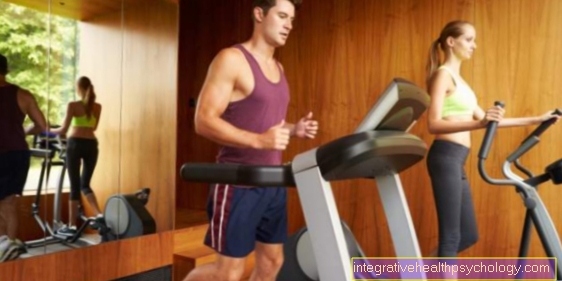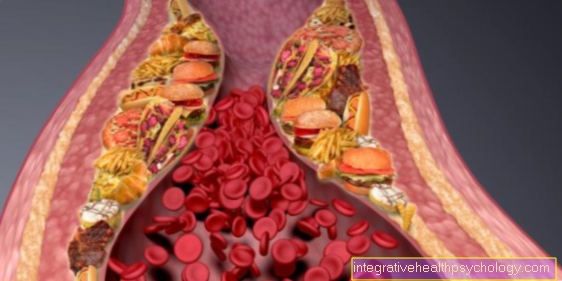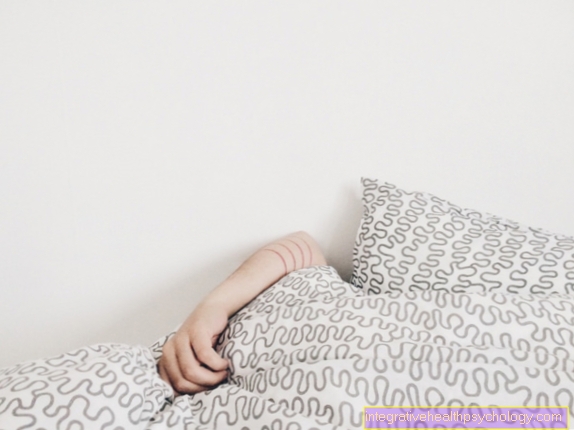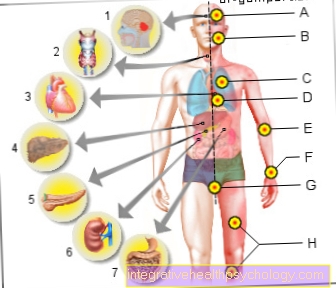The osteoarthritis behind the kneecap
Arthrosis behind the kneecap or "retropatellar arthrosis" is a chronic, degenerative disease of a cartilage area in the knee.
In addition to the tibial plateau and the deep part of the thigh bone, the kneecap also has a significant influence on joint function.
It serves as a guide and pivot point for the patellar tendon in all movements of the knee. The patellar tendon runs from the large quadriceps muscle of the thigh over the knee joint to the shin bone to allow extension of the knee.
The sensitive articular cartilage between the kneecap and the thigh bone can be injured for various reasons and thus significantly restrict the movement in the knee. The causes and manifestations of the disease are numerous, which is why the therapies must be individual and the prognoses can be different.
Read more about this under: Strengthening exercises for knee osteoarthritis and knee osteoarthritis, does acupuncture make sense?

The causes of osteoarthritis
Long-term wear and tear: Most cases of osteoarthritis behind the kneecap are "idiopathic". This means that there is no direct cause behind the cartilage damage, but an interaction of various factors. In the majority of cases, it is a combination of overweight, age, previous injuries and excessive stress in sport or at work.
Patellar dysplasia: Just as often as idiopathic degeneration, patellar dysplasia or another congenital malformation of the joint structures of the knee is behind the osteoarthritis. This is an asymmetrical deformation of the kneecap, which leads to a disruption of the sliding function and uneven wear of the cartilage.
Injury: In a small part of the osteoarthritis degeneration, an injury is the cause. These can be injuries to the kneecap itself or to the cruciate ligaments and menisci.
Injuries are a common cause of osteoarthritis, especially at a young age.
Surgical interventions after knee ligament injuries also increase the risk of osteoarthritis.
Ligament instabilities: A less common cause is what is known as "ligament laxity". This allows the kneecap to run outside the plain bearing and lead to asymmetrical and uneven wear on the cartilage.
Knock knees
The knock-kneed position is a leg axis misalignment in which the knees are too far inward compared to the leg axis.
When standing straight, the thighs and lower legs appear together in an X-shape.
A straight leg axis means that the body weight is distributed exactly over the middle of the knee joint.
However, with a knock-kneed position, most of the weight is on the outer knee, which can cause the cartilage to wear out faster and cause pain.
Arthrosis behind the kneecap is also strongly favored by the misalignment of the leg axis.
Most often the misalignment is congenital, but inflammation, tumors, previous injuries and disturbances in the hormonal balance can also promote the development of knock knees.
Read more about this under: Knock-knees and bow-legs
Obesity
Obesity is one of the most common preventable causes of osteoarthritis of the knee.
Being overweight for many decades increases the likelihood of knee osteoarthritis enormously in old age and significantly reduces the average age of onset.
Even normal walking places considerable additional strain on all joints of the leg, so that the articular cartilages wear out due to pressure.
Restrictions in movement caused by knee pain often increase the sedentary lifestyle and thus promote obesity.
Therefore, the course for a healthy normal weight should be set at a young age.
You can recognize osteoarthritis behind the kneecap by these symptoms
You can recognize osteoarthritis behind the kneecap by these symptoms
- Front knee pain
- Pain when walking
- Pain when climbing stairs
- Start-up pain at the beginning of an activity
- Pain on getting up and in the crouching position
- Pain when going downhill
- Grinding joint noise when moving
- Joint stiffness, restricted mobility and starting problems in the morning
- with activated osteoarthritis, additional swelling, reddening and overheating of the knee
- in advanced stages also pain at rest

I would be happy to advise you!
Who am I?
My name is I am a specialist in orthopedics and the founder of .
Various television programs and print media report regularly about my work. On HR television you can see me every 6 weeks live on "Hallo Hessen".
But now enough is indicated ;-)
The knee joint is one of the joints with the greatest stress.
Therefore, the treatment of the knee joint (e.g. meniscus tear, cartilage damage, cruciate ligament damage, runner's knee, etc.) requires a lot of experience.
I treat a wide variety of knee diseases in a conservative way.
The aim of any treatment is treatment without surgery.
Which therapy achieves the best results in the long term can only be determined after looking at all of the information (Examination, X-ray, ultrasound, MRI, etc.) be assessed.
You can find me in:
- - your orthopedic surgeon
14
Directly to the online appointment arrangement
Unfortunately, it is currently only possible to make an appointment with private health insurers. I hope for your understanding!
Further information about myself can be found at
Pain when going downhill
The pain when going downhill is a typical leading pain of osteoarthritis behind the kneecap.
Due to the combination of the incline, the increased muscle tension and the increased pressure on the knee from going downhill, the pain is particularly pronounced with this type of movement.
Light movements are possible despite the pain; higher loads, for example through hiking, should be avoided.
The pain can run in waves, depending on the so-called "activation" of the osteoarthritis. If the knee is swollen and reddened, the sensitivity to pain is likely to increase.
Pain when climbing stairs
Climbing stairs is also a painful challenge with osteoarthritis of the kneecap. Going down stairs in particular is a painful combination of increased pressure and increased muscle tension to cushion the weight.
However, the exact process of climbing the stairs can be improved with the help of a physiotherapist. When climbing stairs, you should primarily pay attention to the leg axis.
The increased strain on the feet and toes also relieves the knee.
The learned movements take getting used to, but can make climbing stairs much more pleasant.
Knee joint effusion
The knee joint is surrounded by a joint capsule, which is lined on the inside by a layer of mucous membrane. Small amounts of fluid are kept inside the capsule to make movement easier and to lubricate the articular surfaces.
With injuries to the knee but also with chronic degenerative diseases, joint effusions can occur in the knee. Internal irritation of the joint causes excessive synovial fluid to be produced. The fluid collects within the joint capsule, cannot drain away and thus leads to an increase in pressure on the joint structures.
Swellings are visible from the outside, redness is also noticeable, and the function of the knee joint is severely restricted by the accumulation of fluid.
The effusion may have to be punctured with a needle and suctioned off.
overheat
Like the pain, redness, swelling and impaired joint function, overheating is a sign of inflammation.
Overheating indicates an active inflammatory process in the knee, which can occur in phases with osteoarthritis.
The wear and tear of the cartilage behind the kneecap can lead to irritation and irritation, as a result of which the so-called "synovial membrane" inside the knee produces more synovial fluid.
This so-called "activation" of osteoarthritis is accompanied by severe pain, swelling and overheating. After a while, the inflammatory process usually subsides again.
Cracking the kneecap
A cracking of the kneecap is initially not considered to be a disease. Many people complain of the joints cracking without damage or other illnesses in the knee.
However, the cracking can also appear as a symptom of osteoarthritis behind the kneecap.
Especially in advanced stages, when bone rubs on bone, rubbing, grinding and cracking noises can be heard even with slight movements.
The cracking, on the other hand, can also indicate cracking of the kneecap and damage to ligaments and cartilage.
If the kneecap leaves its sliding bearing, there may be snapping and cracking noises due to the friction on bones and ligaments. After injuries to the knee, a cracking sound can indicate that various structures are trapped in the joint.
If the cracking is accompanied by pain, a more detailed diagnosis may have to be carried out.
diagnosis
The diagnosis begins with an inquiry into the exact symptoms and a physical examination.
Typical start-up pain or pain when walking downhill already indicate cartilage damage behind the kneecap.
The osteoarthritis cannot be detected with an ultrasound examination, but potential joint effusions can already be determined and, if necessary, punctured.
If the suspicion of osteoarthritis behind the kneecap is confirmed, radiological images such as X-rays and MRI images should be made.
The structures of the bones of the knee joint and the shape of the patella can be clearly seen in the X-ray. Conventional knee osteoarthritis can already be guessed at by narrowing the joint space. The ligaments and cartilage can be shown with better resolution in the MRI.
In order to clearly see the cartilage damage, an endoscopy can be performed.
However, it is an invasive procedure with risks and should only be used if there is a possibility of treating and alleviating osteoarthritis by means of knee mirroring.
Read more about the topic under: Diagnosing osteoarthritis
X-ray image
Using special techniques, the kneecap can also be shown well in the X-ray image.
The recording is carried out horizontally and with different flexions of the knee in order to recognize the kneecap in its sliding bearing and to be able to understand its movement with various extensions and flexions of the joint.
Statements can also be made about the structure of the back surface of the kneecap. Advanced arthrosis behind the kneecap can be clearly identified in this way.
In order to be able to make statements in the initial stages, however, an MRI of the knee often has to be performed.
MRI of the knee
Magnetic resonance tomography is radiation-free and high-resolution imaging, but it is more complex and is associated with higher costs.
Soft tissue in particular can be displayed in high resolution in the MRI.
The MRI of the knee is used for all cartilage, ligament and tendon injuries in order to obtain high-resolution images of the inside of the knee.
Inflammatory changes in the cartilage, joint effusions, cartilage damage and pieces of cartilage floating freely in the joint can also be excellently diagnosed in the MRI.
Training and sports
The exercise of sport must be carefully considered in the case of osteoarthritis behind the kneecap.
Intensive stress often intensifies the symptoms and the clinical picture, while light physiotherapeutic training units can have a therapeutic effect on osteoarthritis.
Elderly patients can take specific courses that are gentle on the joints and focus on stretching exercises, maintaining movement and strengthening the stabilizing muscles.
Fitness studios are also often funded by health insurance for patients of all ages.
It is important, however, that training is instructed by experienced doctors or physiotherapists so as not to put incorrect stress on the joint.
A common relieving exercise for osteoarthritis behind the kneecap are rocking exercises. The person concerned sits down on a chair and puts his feet on tiptoe.
Then he rocks his foot until the feet are supported on the heel. This rocking can be done for a few minutes at a time
Also while sitting, an object of different weight on the floor can be grasped from both sides with the feet and then lifted by stretching the knees. This specifically strengthens the extensor muscles. Light movement exercises can also be performed in bed, for example before going to bed.
To do this, the legs can be moved like when cycling or simply alternately bent and stretched.
Keeping your legs in the air can also be a good exercise for the leg muscles.
To strengthen the muscles of the rear legs, the same exercises can be performed lying on your stomach.
Read more about this under: Knee arthritis, can you still jog? and knee osteoarthritis, which sport is advisable
These sports are allowed
For older people there are often courses that are easy on the joints, as well as retirement sports, stretching and strengthening exercises, preventive courses, aqua aerobics or courses in the fitness studio.
But there are also numerous joint-friendly sports for younger sufferers.
These include cycling, swimming, yoga and aqua jogging. Nordic walking, hiking and golf can also be a sensible alternative to joint-stressing sports for those with mild complaints. In principle, you should consult a doctor before exercising.
In the case of mild complaints, it is often enough to reduce strenuous sports. In the case of advanced osteoarthritis, however, water sports are often the only remaining alternative.
The treatment
The treatment of osteoarthritis behind the kneecap is highly dependent on the stage of the disease and is often lifelong.
The spectrum of possible therapies ranges from protection to surgical joint replacement and depends primarily on the pain and the severity of the symptoms.
- Rest, change the sport, reduce the training intensity
- Prescription of insoles, knee braces and physiotherapy
- Weight reduction, strengthening of the thigh muscles
- Pain relievers and anti-inflammatory drugs (NSAIDs)
- Cortisone, hyaluronic acid and autologous blood injections into the knee
- Interventions using knee imaging / arthroscopy
- surgical cartilage transplants
- Partial joint replacement, surface prosthesis behind the kneecap
- cemented or non-cemented knee prosthesis
Read more on the topic: Knee osteoarthritis, which drugs help?
insoles
Nowadays, insoles in shoes are adapted to the feet in such a way that they can have a significant influence on the leg axis, the position of the legs and feet and even on the lower spine and hips.
A common cause of arthritis and cartilage wear in the knee is a misalignment of the leg axis.
In particular, the common mean knee osteoarthritis, which is favored by a bow-leg position, can still be treated with insoles in many stages today.
With the help of a raised outer edge in the shoe, the knee can be shifted centrally to the axis, which relieves pressure from the joint cartilage in the middle knee area.
Hyaluronic acid
Hyaluronic acid is a liquid that is naturally produced by the joint cartilage and, thanks to its slimy consistency, helps the joints slide smoothly and the joint surfaces are lubricated. With osteoarthritis, the increasing loss of the joint cartilage also leads to a loss of the sliding properties of the joint surfaces.
Hyaluronic acid can be injected into the joint as a symptomatic therapeutic approach in these cases. It replaces the natural synovial fluid for a short time, but cannot achieve any lasting improvement in joint properties. In individual cases, the hyaluronic acid injection can reduce the osteoarthritis pain for a few months and improve mobility in the joint.
Knee brace
A knee bandage can be worn on the knee for both therapeutic and preventative purposes.
It primarily fulfills the functions of relieving and stabilizing the joint.
In the case of osteoarthritis behind the kneecap, the bandage can relieve the kneecap by applying light pressure on the joint, reduce the pain of osteoarthritis and improve movement in the joint.
Again, this is only a symptomatic relief of the symptoms and not a sustainable treatment of osteoarthritis.
In sport, bandages can be worn preventively. They stabilize the knee joint even in healthy people and lead to movements being carried out more consciously.
Abrupt movements and knee injuries, which can trigger or advance osteoarthritis, are thus reduced.
When can surgery help?
In the early stages, an incipient cartilage damage can be stopped by various measures so that an operation is not necessary.
However, the time of an operation is determined by the person concerned, depending on the pain and movement restrictions in the knee.
Various operative procedures are available for this. Joint-preserving interventions should be a priority, especially for young patients.
In rare cases, cartilage transplants can be performed when the cartilage is young enough and capable of regeneration.
Operations can also help if the knee is causing pain due to the trapping of cartilage structures or freely movable pieces of cartilage and bone in the joint.
These symptoms can be remedied with a jointoscopy. In advanced stages of osteoarthritis behind the kneecap, however, partial knee prostheses or full knee prostheses can also be used.
This is made dependent on the patient's condition, age, mobility and chances of recovery.
Read more on the subject under: Knee osteoarthritis, when do you have to operate? and knee osteoarthritis, when to treat conservatively?
Minimizing risk factors
The most typical risk factors for osteoarthritis behind the kneecap are obesity, patellar deformations and previous knee injuries.
Lifestyle changes cannot reduce patellar dysplasia. In contrast, knee injuries can be reduced and minimized using many methods.
First and foremost is a conscious and careful exercise of sport.
Skiing, soccer, basketball, tennis and numerous ball sports are the most dangerous sports for the knees.
If the knees are damaged or the ligament is loose, these sports should be avoided as far as possible. Knee supports and good sports equipment can also contribute to more conscious exercise of the sport.
The strength of the leg muscles also plays a significant role in the susceptibility to injury.
The risk factor that is easiest to influence is being overweight. Weight loss helps in the long run to relieve the stress on the cartilage and reduce normal wear and tear over time.
Read more on the subject under: Obesity and weight loss
forecast
Arthrosis behind the kneecap is basically a chronic cartilage disease that is not reversible.
Reconstruction and healing of the damaged cartilage are not possible today.
Cartilage transplants can only provide a promising treatment method for young patients with good conditions.
By adapting the lifestyle and sports behavior, the onset of osteoarthritis can be delayed and stopped.
However, osteoarthritis at a young age is associated with a significantly poorer prognosis over the lifespan.
Thanks to modern prosthetics in surgery, partial knee prostheses or complete joint prostheses can be very successful.
The functional duration of the prostheses also increases significantly, so that they can also provide long-term relief from osteoarthritis behind the kneecap over decades.
Read more on the topic
For more information, see:
- Knee osteoarthritis
- Pseudoarthrosis
- Osteoarthritis attack
- Arthrosis stages





























